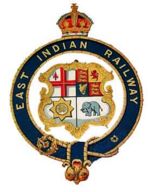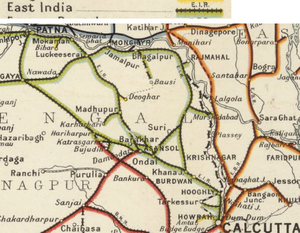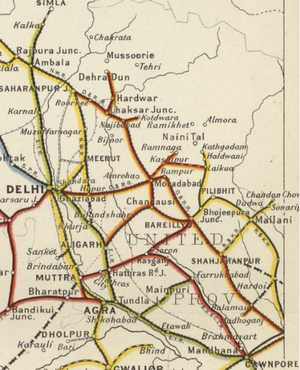East Indian Railway: Difference between revisions
1909 Railway Map Section added |
'EIR Railway Lines' modified - Link created to new page ' East Indian Railway - Lines owned and worked'; old info deleted |
||
| Line 143: | Line 143: | ||
# Medical | # Medical | ||
# Printing | # Printing | ||
# | # Provident Institution | ||
# Stores | # Stores | ||
# Traffic - [[Calcutta]] (Head Office); [[Allahabad]]; [[Asansol]]; [[Cawnpore]]; [[Howrah]]; Howrah Goods; [[Delhi]]; [[Dhanbaid]]; [[Dinapore]]; [[Gaya]]; [[Sahebgunge]]; [[Tundla]] | # Traffic - [[Calcutta]] (Head Office); [[Allahabad]]; [[Asansol]]; [[Cawnpore]]; [[Howrah]]; Howrah Goods; [[Delhi]]; [[Dhanbaid]]; [[Dinapore]]; [[Gaya]]; [[Sahebgunge]]; [[Tundla]] | ||
| Line 151: | Line 151: | ||
==EIR Railway Lines== | ==EIR Railway Lines== | ||
The EIR owned and worked on behalf of other parties an extensive network of broad gauge([[Rail_gauge#Broad_Gauge|BG]]) lines. | |||
See '''[[East Indian Railway - Lines owned and worked]]''' for details and information:- | |||
*BG Lines - owned and worked by EIR | |||
*BG Lines absorbed into EIR | |||
* | *BG Lines worked by EIR at some time | ||
* | *BG Lines - EIR network expansion lines | ||
* | |||
* | |||
==Records== | |||
== Records == | |||
Refer to FIBIS Fact File #4: “Research sources for Indian Railways, 1845-1947” - available from the [http://www.fibis.org/store/fibis-books-and-publications/bff-0004-research-sources-for-indian-railways-1845-1947/ Fibis shop]. This Fact File contains invaluable advice on 'Researching ancestors in the UK records of Indian Railways' with particular reference to the [[India Office Records]] (IOR) held at the [[British Library]] | Refer to FIBIS Fact File #4: “Research sources for Indian Railways, 1845-1947” - available from the [http://www.fibis.org/store/fibis-books-and-publications/bff-0004-research-sources-for-indian-railways-1845-1947/ Fibis shop]. This Fact File contains invaluable advice on 'Researching ancestors in the UK records of Indian Railways' with particular reference to the [[India Office Records]] (IOR) held at the [[British Library]] | ||
Revision as of 07:16, 12 November 2016
| East Indian Railway | ||
|---|---|---|
 Howrah Station, Calcutta | ||
| Line of route | ||
| Howrah (Calcutta) to Delhi | ||
| Gauge / mileage | ||
| Broad gauge | 1962 miles (1905) | |
| Timeline | ||
| 1849 | Guarantee agreed with East India Company | |
| 1851 | Construction begun | |
| 1854 1867 1871 |
First train between Howrah and Hooghly First through train to Delhi First through train to Bombay via Jubbalpore | |
| 1880 | Line acquired by State | |
| Key locations | ||
| Presidency | Bengal | |
| Stations | Agra, Benares, Hooghly, Mirzapur, Patna | |
| System agency | ||
| 1880 | worked by East Indian Railway Company | |
| How to interpret this infobox | ||
| East Indian Railway | ||
|---|---|---|
 East Indian Railway device | ||
| System timeline | ||
| 1880 | EIR re-formed to work line now owned by State | |
| 1925 | Management of system taken over by State | |
| Constituent companies / lines | ||
| 1880 | East Indian Railway | |
| 1889 | Delhi-Umballa-Kalka Railway | |
| South Behar Railway | ||
| 1885 | Tarkessur Railway | |
| Jind-Panipat Railway | ||
| 1925 | Oudh and Rohilkhand merged into EIR | |
| Key locations | ||
| Headquarters | Calcutta | |
| Workshops | Jamalpur, Liluah | |
| Major Stations | Agra, Benares, Howrah, Patna | |
| Successor system / organisation | ||
| 1947 | Eastern Division, Indian Railways | |
| 1952 | split between Eastern & Northern Railways (IR zones) | |
| System mileage | ||
| Broad gauge | 2225 miles (1905) 4011 miles (1943) | |
| Associated auxiliary force | ||
| East Indian Railway Regiment | ||
| How to interpret this infobox | ||



Built on the same terms and conditions as the Great Indian Peninsula Railway (GIPR), the East Indian Railway (EIR) was a British company, registered in London, privately owned and financed, operating under license and guarantee from the (British) Board of Control in India and the East India Company (EIC).
By 1859, the arrangements were "the construction and working of lines from Calcutta to Delhi, and from Allahabad to Juppulpore - total, about 1,400 miles. Capital - 12,731,000l. This amount has been sanctioned for the works specified, but it is probable that a larger sum will be required. Rate of Interest Guaranteed - 5 per cent. on 11,553,000l. capital; 4½ per cent. on 1,178,000l. debentures, convertible into shares." [1]
History
In January 1844 Rowland Macdonald Stephenson published an article in the leading daily paper, 'The Englishman', with his proposals, illustrated by a large map of India, showing the whole system of lines which he held to be most suitable for the country. This gained Government support and he returned to London after reinforcing his position with the merchants of Bengal. Back in England, Stephenson proposed formation of a company with the title “'East Indian Railway Company” [2]
The East Indian Railway Company (EIR) was formed in May 1845 with a power to raise a capital of 4 million pound sterling and Stephenson was the first Agent and Chief Engineer.
After four years of protracted negotiation and strenuous efforts, including a direct appeal to the British Prime Minister, a contact was signed in August 1849 between the EIR and the EIC and became one of the three original guaranteed companies sanctioned to construct experimental lines. It was not until August 1854 that the EIR opened its first section from Howrah to Hooghly, a distance of 24 miles (38km. On 3rd February, 1855, the first portion of the line, 121 miles(194km) from Howrah) to Burdwan ( towards Delhi), was opened by Lord Dalhousie [3].
Formed in 1845, the EIR was not contracted by the EIC to begin railway construction until 1849 when it became one of the three original guaranteed companies sanctioned to construct experimental lines. It was not until 1854 that the EIR opened its first section from Howrah to Hooghly.
In the spring of 1857 the Indian Mutiny broke out and as a consequence a large portion of the work of construction was delayed[4]. Eight members of EIR staff lost there lives and remembered on the Memorial at Cawnpore Church[5]
By 1864, the EIR had arrived in Delhi although it was not until 1871 that the Bombay-Calcutta route was completed when the GIPR reached Juppulpore.
By 1865, with the opening of the Naini Bridge (over the Jamuna River at Naini, near Allahabad), there was a through line from Howrah (on the right bank of the Hoogly River facing Calcutta) to Agra (on the left bank of the Jamuna River facing Agra, a line length of 1017 miles(1630km) [3]
In 1866 the Yamuna Railway Bridge (Delhi) was constructed in 1866 by the East India Railway (EIR) and connected the two principal cities of North India Calcutta and Delhi; this being the last link of the trunk line on this route. [6]
The Government of India (GoI) acquired the assets of the EIR on 31 December 1879 while leaving the management to the private company.
In 1887 the Jubilee Bridge was completed, crossing the Hooghly River between Naihati and Hooghly. The bridge was constructed by the EIR and connected to the East Bengal Railway(EBR) enabling freight traffic from upper India to run to the Port of Calcutta [7].
Progressive development of the EIR network continued such that by 1918 there was over 2400 miles (3840km) of broad gauge(BG) track.[8]
The GoI took over the direct running of the EIR on 1 January 1925.
'Indian Railways' - In 1952, the EIR was split to form two zones of Indian Railways. The Moradabad, Lucknow & Allahabad Division was subsuned into Northern Railway while the remainder was merged with the Bengal-Nagpur Railway (BNR) to form Eastern Railway. This latter merger was not considered a success as, in 1955, BNR was demerged to form South Eastern Railway.
Locomotive, Carriage & Wagon Workshops
- The first workshops to build Locomotives, Carriages and Wagons were established in Howrah and operational in the mid 1850’s.
- In 1862, the EIR Locomotive Workshops at Jamalpur were completed leaving the EIR Carriage and Wagon Workshop at Howrah.
- By 1900 the new EIR Carriage and Wagon Workshop at Lillooah (3Km up line from Howrah) was established.
- On 15 January 1934, the Jamalpur Locomotive Workshops, along with the entire railway colony, were destroyed by an earthquake. It took 3 years to rebuild the facility.
Organisation
By 1914, EIR was organised into the following departments, each with its own workshops with the main ones shown.
- Agency
- Audit & Accounts
- Carriage & Wagon - Lilloah; Allahabad
- Colliery
- Electrical
- Engineering
- Locomotive - Allahabad; Asansol; Dhanbaid; Dinapore; Jamalpur; Tundla
- Medical
- Printing
- Provident Institution
- Stores
- Traffic - Calcutta (Head Office); Allahabad; Asansol; Cawnpore; Howrah; Howrah Goods; Delhi; Dhanbaid; Dinapore; Gaya; Sahebgunge; Tundla
Schools
The EIR operated many schools, of which probably the best known was Oak Grove School at Mussoorie. Oak Grove School is still associated with Indian Railways and Northern Railway.
EIR Railway Lines
The EIR owned and worked on behalf of other parties an extensive network of broad gauge(BG) lines.
See East Indian Railway - Lines owned and worked for details and information:-
- BG Lines - owned and worked by EIR
- BG Lines absorbed into EIR
- BG Lines worked by EIR at some time
- BG Lines - EIR network expansion lines
Records
Refer to FIBIS Fact File #4: “Research sources for Indian Railways, 1845-1947” - available from the Fibis shop. This Fact File contains invaluable advice on 'Researching ancestors in the UK records of Indian Railways' with particular reference to the India Office Records (IOR) held at the British Library
An on-line search of the IOR records relating to this railway [9] gives many references. The most important being:-
- L/AG/46/11 “Records of the East Indian Railway Company; 1844-1953”
- L/AG/46/31 “Records of the India Office relating to the East Indian Railway Company; 1879-1952”
Personnel
The following employment records held at the IOR are relevant :-
- L/AG/46/11/133-137 "Contracts of appointment, c1858-1925" (possibly not all included)
The above is indexed in
- Z/L/AG/46 "Index to UK Appointments to Indian Railways (1849-1925)"
- FIBIS database List of Indian Railways UK Contracted Staff taken from IOR Series L/AG/46/12.
The following is not included in the index Z/L/AG/46.
- L/AG/46/11/138-141 : "Half-yearly staff lists, 1861-1890 & 1911-1922" (giving ages from 1886).
East Indian Railway Personnel gives details of notable EIR staff from many different sources.
- These have been listed by EIR Department and in Chronological order.
- The entries link to the Notable Railway People pages.
Thacker's Directories The following for East Indian Railways Personnel have been indexed in Grace's Guide -
- 1856 Thackers East Indian Railways Personnel
- 1861 Thackers East Indian Railways Personnel
- 1867 Thackers East Indian Railways Personnel
- 1872 Thackers East Indian Railways Personnel
- 1877 Thackers East Indian Railways Personnel
- 1882 Thackers East Indian Railways Personnel
East Indian Railway Company Records The following have been indexed in Grace's Guide
FIBIS resources
- List of Indian Railways UK Contracted Staff taken from IOR Series L/AG/46/11. FIBIS database
- Index to V/13/244 East Indian Railway Staff List 1914FIBIS database
- "The Indian Railways and a dynasty of Pearce's (1855 to 1930)", FIBIS Journal, Spring 2011, Number 25 page 13-16.
- "The Walsh Family and the Cawnpore Massacre" by Paddy Walsh FIBIS Journal Number 31 (Spring 2014) pages 3-15.
- William Walsh was working for the East Indian Railway as a Railway Inspector at the time of the massacre, having joined c 1856-57 after retiring as a pensioned Sergeant, Bengal Artillery.
- For access, see FIBIS Journals
Recommended reading
- Blair Williams, "EIR at Jamalpur - Anglo-Indian Railway Officers", The International Journal of Anglo-Indian Studies (Vol 6, No 2, 2001).
- "The Carriage and Wagon Workshops of the East Indian Railway", The Indian Railway Gazette, 1st February 1908, page 33-35.
- "Development of the East Indian Railway", Railway Age Gazette, 1st August 1913, Vol.55, No 5, page 191-195.
- "East Indian Railway", The Railway Gazette, 1st November 1929, page 21-32 & 113-114.
Associated Auxiliary Force
External links
- East Indian Railway logo
- Science & Society Picture Library
- "History of Eastern Railway", Indian Railways Fans Club.
- EIR Picture Gallery, Indian Railways Fans Club.
- How Railways made tracks in India September 29, 2003 thehindubusinessline.in
- Imperial Indian Mail (and other trains) trains-worldexpresses.com
- H.M. Government “Statute Law Repeals: Nineteenth Report : Draft Statute Law (Repeals) Bill; April 2012"; pages 122-126, paragraphs 3.32-3.50
Historical books online
- George Huddleston, History of the East Indian Railway (Calcutta: Thacker, Spink & Co, 1906). Archive.org. [A second part, published in 1939, took the history to 1924.]
- "The East Indian Railway", page 358 from Bengal and Assam, Behar and Orissa: their history, people, commerce and industrial resources by Somerset Playne and J W Bond 1917 Archive.org
- The Early History Of The East Indian Railway by Hena Mukherjee 1960. Pdf download, Digital Library of India
Published books
- Mukherjee, Hena. The Early History of the East Indian Railway 1845-1879. Published by Firma KLM Private Limited, Calcutta 1994.
- "Symphony of Progress: The Saga of Eastern Railway 1854-2003 published by the Eastern Railway in Kolkata 2003. website of Eastern Railway, Sealdah
References
- ↑ "Money Market and City Intelligence", The Times, Wednesday, 15 June 1859, #23333, 7a]; Retrieved 17 Dec 2015
- ↑ Grace's Guide "Rowland Macdonald Stephenson" Retrieved on 4 Jun 2016
- ↑ 3.0 3.1 "Symphony of Progress: The Saga of Eastern Railway 1854-2003" published by the Eastern Railway, Kolkata 2003, page 7, 10, 14
- ↑ Archive.org "History of the East Indian Railway ..." by George Huddlestone Appendix B, page 19, pdf page 40; Retrieved 11 Jun 2016
- ↑ Archive.org "History of the East Indian Railway ..." by George Huddlestone Appendix B, pages 280, pdf page 335; Retrieved 11 Jun 2016
- ↑ Wikipapia "Yamuna Railway Bridge (Delhi)"; Retrieved on 4 Jun 2016
- ↑ “Symphony of Progress - The Saga of the Eastern Railway 1854-2003”; published by Eastern Railway, kolkata 2003; page 30
- ↑ " Administration Report on the Railways in India – corrected up to 31st March 1918"; Superintendent of Government Printing, Calcutta; pages 53-61; Retrieved 17 Dec 2015
- ↑ British Library “British Library Archives and Manuscripts Catalogue” - Search; Retrieved 22 Jan 2016